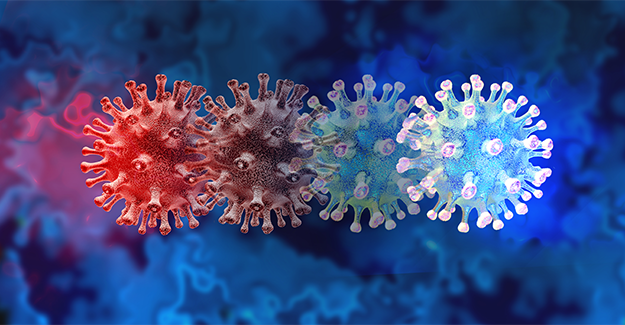A protein shift in a canine coronavirus could explain how other coronaviruses (including SARS-CoV-2) jump to humans

Researchers at the Cornell College of Veterinary Medicine used state-of-the-art molecular evolution tools to assess how pressures from natural selection may have influenced the canine coronavirus’ evolution.
It all hinges on a protein shift.
Lead researcher Michael Stanhope, PhD, a professor of public and ecosystem health at Cornell’s College of Veterinary Medicine, and his team identified a protein shift that occurs in canine coronavirus that points to a possible pattern of change found in other coronaviruses and which may provide clues to how they make the zoonotic jump to humans from animals. They reported their findings in a new study.
Their journey started when a new canine coronavirus first identified in two human patients in Malaysia who’d developed pneumonia in 2017. Another group of scientists isolated the canine coronavirus, sequenced it, and published their findings in 2021.
Building on that earlier research, Stanhope and his team identified a pattern that occurs in the canine coronavirus spike protein—the area of the virus that penetrates a host cell: The virus shifts from infecting both the intestines and respiratory system of the animal host to infecting only the respiratory system in a human host.
The researchers identified the shift in the canine coronavirus as one that also occurs in another coronavirus—one that jumped from bats to humans and caused respiratory illness
The study identified some of the molecular mechanisms underlying a host shift from dog coronavirus to a new human host, that may also be important in the circulation of a new human coronavirus that we previously didn't know about, said Lead researcher Michael Stanhope, PhD, a professor of public and ecosystem health at Cornell’s College of Veterinary Medicine.
NEWstat reached out to Stanhope to find out more.
“In dogs, coronaviruses cause an enteric (gastrointestinal) infection,” Stanhope said. “This canine coronavirus was instead linked to respiratory illness in these patients in Malaysia. So, this is a tropism shift (the ability of a given virus to productively infect a particular cell) in the virus in the sense that it is both infecting a new host, and also infecting a different cellular environment—enteric versus respiratory.”
Canine coronaviruses are classified within the genus Alphacoronavirus, Stanhope said. “This genus of coronavirus includes an important example of a jump from bats to humans—a human cold virus called HCoV229E. This virus jumped from bats to humans (an enteric to respiratory shift), and in the process it lost a portion of the spike protein, called the O-domain. This same portion of the spike protein was changing in unique ways in the Malaysian canine coronavirus.”
Stanhope told NEWStat that this change is significant: “It suggests a pattern that occurs in coronaviruses that is correlated with zoonotic infections.”
He said the canine coronavirus spike protein had what’s referred to as “relaxed selection” in the O-domain: “The nucleic acids that comprise and code for that region of the protein were changing in a manner that suggested they were not subject to the same natural selection pressure as other typical canine and porcine enteric viruses,” Stanhope said. “The O-domain appeared to be losing, or possibly already lost its usual function—which includes binding to a co-receptor on the host called sialic acid.” When the O-domain binds to sialic acid, it helps facilitate enteric infection. “The Malaysian coronaviruses had unique changes in the sialic acid binding region which may have reduced or eliminated its ability to bind this coreceptor in the dog host.”
Stanhope said this region of the spike protein in SARS-CoV2 is receiving increasing attention from researchers: “Our study provides additional rationale to focus on this specific area of the molecule—particularly with regard to questions of zoonotic infection.”
Another point to consider:
“This same canine coronavirus found in these Malaysian patients has now been reported in a patient from Haiti,” Stanhope added, and said it suggests one of two possibilities:
- It jumped from another dog—or cat (cats have receptors that will accommodate both canine and feline coronaviruses) in an entirely different part of the world—which would mean two independent zoonotic jumps.
Or
- (And more likely) This virus is circulating at some low level in the human population, and “We haven’t noticed it because nobody was looking for it.”
Photo credit: © wildpixel/iStock/Getty Images Plus via Getty Images



